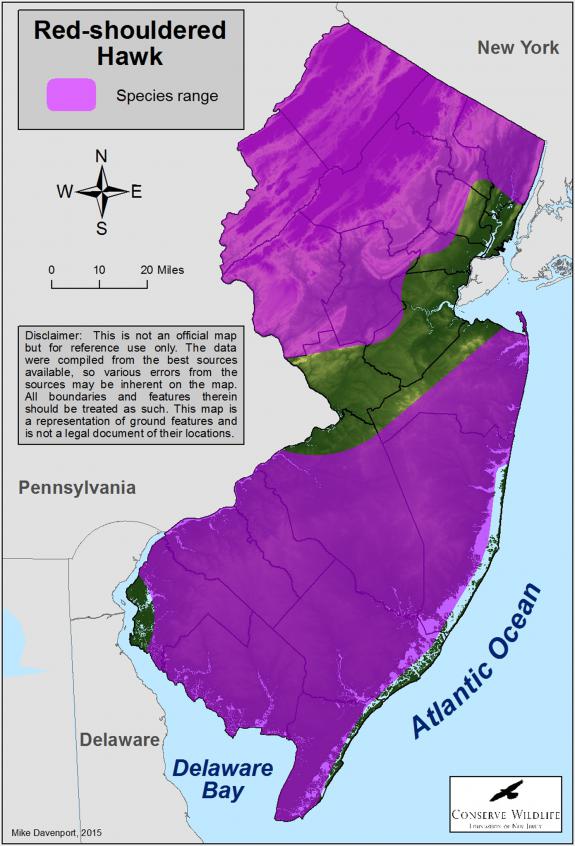Buteo lineatus
Type: bird
Status: endangered
Species Guide
Red-shouldered hawk
Buteo lineatus
Species Type: bird
Conservation Status: endangered
Identification
The red-shouldered hawk is a small “buteo” (pronounced “beauty-o”), or soaring hawk. It gets its name from red or rust-colored patches on the upper shoulders. The head and back are dark brown. It has bold black and white stripes on its tail and flight feathers, red-orange chest, and pale underwing feathers. Although females average slightly larger than males, plumage is similar for both sexes. The call of the red-shouldered hawk is a series of nasal drawn-out “aahhh” cries. It is one of the most beautiful hawks in eastern North America.

Distribution & Habitat
It ranges in North America along the Atlantic Coast from New England to Florida, west to the Mississippi River Valley into Texas and Florida with a small isolated population along the coast of California. In New Jersey, the red-shouldered hawk is a year-round resident, but during spring and fall many migrate through the state along the Atlantic Flyway. Its habitat is comprised of forested areas that are periodically flooded (e.g., forested wetlands). They build stick nests in a crotch or fork in large trees that are below the forest canopy. Pairs exhibit a high level of site fidelity returning to the same nest site, year after year, though not necessarily the same nest tree.
During the non-breeding season, red-shouldered hawks are less restrictive in their habitat use. They inhabit the traditional wetland forests occupied during the breeding season as well as uplands, fragmented woods, smaller forests, open areas, and edges.
The red-shouldered hawk is one of the most beautiful hawks in eastern North America.
Red-shouldered hawks require large areas of unfragmented forested habitat (between 250-650 acres) to nest. They will usually nest more than 3,000 feet away from the nearest house, although there are a few pairs in northern New Jersey that have set up residence in closer proximity. These hawks are easily disturbed by human activities (e.g., hiking, off-road vehicles) and can be forced off a nest early in the season if they feel threatened. Habitat requirements and human disturbance severely restrict the breeding range of the red-shouldered hawk in New Jersey and may be limiting their population growth.
Diet
Red-shouldered hawks consume a wide variety of prey items that differ between their breeding and non-breeding seasons and prey availability. During the breeding season they are known to consume frogs, snakes, lizards, insects, salamanders, spiders, crayfish, snails, small turtles, and a few birds and small mammals. During migration, these hawks are highly opportunistic, or they prey on anything that is available and plentiful. In winter, their diet shifts almost entirely to songbirds and small mammals. They are known to hunt from perches or by active flight in search of prey.
Life Cycle
Courtship begins in late March-early April when the male performs courtship displays to attract potential mates. He will fly in circles around his nesting territory and call repeatedly with his feathers fanned out on display. He performs steep dives prior to mating to strengthen the pairs bond during courtship. Pairs mate for life and sometimes use the same nest site for many years. They build nests in crooks and forks of large deciduous trees. Sometimes they occupy old nests built by other hawks, owls, crows, or even squirrels.
Females lay 3 to 4 eggs in late March to May that are incubated for around 33 days. The young hatch asynchronously, or in the order that they were laid. This adaptation gives the oldest young the best chance at surviving if there is a lack in prey or if an adult dies before the young leave the nest. The young are cared for by the adults for another 10 to 15 weeks or until they can hunt on their own. The young will return to nest near where they originated.
Current Threats, Status, and Conservation
Today it is believed that fewer than 200 pairs of red-shouldered hawks breed in New Jersey, and little is known about whether this number is increasing or decreasing. The clearing of forests and filling of wetlands contributed to the decline of this species. The earliest records of this decline were noted as early as the mid-1920s. As development increased and forests became fragmented during the 1950-70’s, reduced numbers of red-shouldered hawks were observed in New Jersey. As a result, the red-shouldered hawk was listed as a threatened species in New Jersey in 1979. The population continued to suffer from more habitat loss and this prompted the Endangered and Nongame Species Program to upgrade their listing to endangered in 1991.
“Habitat that is essential to this species continues to be lost or degraded by development and forest fragmentation.”
Since 1991, little is known about the overall population trend of Red-shouldered hawks in New Jersey. Woodland raptor surveys and sighting report forms (from the public) provide the Endangered and Nongame Species Program (ENSP) with data to judge population trends. Habitat that is essential to this species continues to be lost or degraded by development and forest fragmentation. ENSP is conducting research to calculate the population trend along sample survey routes in relation to the surrounding habitats. We are hopeful that the data analysis will reveal some positive news.
References
Beans, B. E. and Niles, L. 2003. Endangered and Threatened Wildlife of New Jersey.
Edited and updated in 2010 by Ben Wurst. Main photo by Bob Cunningham.
Scientific Classification
- Kingdom: Animalia
- Phylum: Chordata
- Class: Aves
- Order: Falconiformes
- Family: Accipitridae
- Genus: Buteo
- Species: B. lineatus